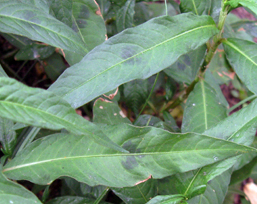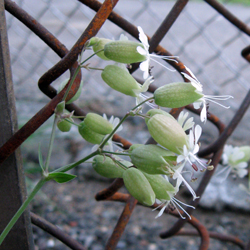Lady’s Thumb
 This post is late because I’m busy moving to a new city. Fortunately, today’s plant can be found in almost any American city, eking out a living in the tiniest cracks between pavement slabs.
This post is late because I’m busy moving to a new city. Fortunately, today’s plant can be found in almost any American city, eking out a living in the tiniest cracks between pavement slabs.
Lady’s Thumb (Persicaria maculosa) is a member of the Buckwheat family, and it counts rhubarb and buckwheat among its more illustrious relatives.
This plant is native to Europe. I don’t know if it was brought to North America because it was edible (though your mileage may vary) or because of its purported medicinal qualities, or if its tiny black seeds hitched a ride in a shipment of grain. Regardless, it found the New World to be very inviting.
This tough little plant now thrives deep in the concrete jungle. I remember coming across one of them when I was five years old and living in Philadelphia; it was protruding improbably from a little rift in the pavement outside my home. I puzzled over the clump of bubblegum-pink beads that were, it turns out, its flowers.
 The name Lady’s Thumb comes from a spot on the leaves that supposedly looks as if a lady pressed her (very dirty?) thumb against it. This spot helps distinguish Lady’s Thumb from some of its relatives that are native to North America.
The name Lady’s Thumb comes from a spot on the leaves that supposedly looks as if a lady pressed her (very dirty?) thumb against it. This spot helps distinguish Lady’s Thumb from some of its relatives that are native to North America.
I’ve been focusing on non-native plants on this blog so far; the truth is that the world of urban botany has as much to say about the travels of humans as it does about plants. Still, I promise to feature a native plant on Friday. There are native plants in the city, jostling leaf-to-leaf with Lady’s Thumb and all the rest.
Norway Maple
 There may be an imposter living in your backyard.
There may be an imposter living in your backyard.
Full disclaimer: I grew up in Canada, and I’ve always been a sucker for the Sugar Maple tree. Its leaf is found on our flag and everything else that is patriotic. But people in the US Northeast also love this tree because it provides the sap for maple syrup. (This sweet quality is reflected in its Latin name, Acer saccharum.)
So I was surprised to learn that many of the “Sugar Maples” lining Canadian and American streets aren’t Sugar Maples at all. They’re members of a look-alike species from Europe called the Norway Maple, Acer platanoides.
The Norway Maple was brought to North America in the mid-1700s. It was a popular garden tree; even George Washington was thrilled to score himself a couple of Norway Maples for his yard. In urban areas, it proved to be the ultimate secret replacement for the beloved Sugar Maple because it was much more tolerant of pollution, road salt and denuded soil.
Unfortunately, the success of the Norway Maple came at a price. It spread into natural areas and displaced native plants (including the Sugar Maple). Its leaves were just a smidgen bigger, and its foliage just a touch thicker, and native seedlings couldn’t grow in its thick shade.
Nowadays it’s considered a dangerous invasive species. Some states have even banned people from planting them.
How can you tell that Norway Maple from the Sugar Maple? There are several subtle clues, but my favorite way to distinguish them is to pick a leaf and snap the stem. Only Norway Maple will exude a milky white sap. Of course, you could always just compare its leaf to the one on a handy bottle of ice cold Molson Canadian beer. Cheers!
Bladder Campion
 Bladder Campion was blessed with one of the least graceful names in the plant world, right up there with Pale Swallowwort and Clammy Ground Cherry.
Bladder Campion was blessed with one of the least graceful names in the plant world, right up there with Pale Swallowwort and Clammy Ground Cherry.
Like many of the flowers in our cities, Bladder Campion is not native to North America. European settlers brought it to the new world for their gardens. This plant took readily to waste spaces, spreading gleefully into gravelly roadsides and abandoned fields.
Several other Campion species were also brought over from Europe. To distinguish this one from the others, note that Bladder Campion has the most impressive, well, bladder (the green tic tac-shaped object just below the white petals), and other Campions have hairy bladders. As an urban botanist, it’s your duty to loudly point out facts like this to your friends, especially at parties.
When I was a kid, my friends and I used to torment these plants by holding the bladders shut to trap air, and then clapping them with our hands so that they would make a loud pop. (Plant nerds: the inflated-looking part is called the calyx, the modified leaves that enclose a young flower.)
This flower will be blooming until September, so keep an eye out as you walk down the street. The Latin name for this flower is Silene cucubalus.